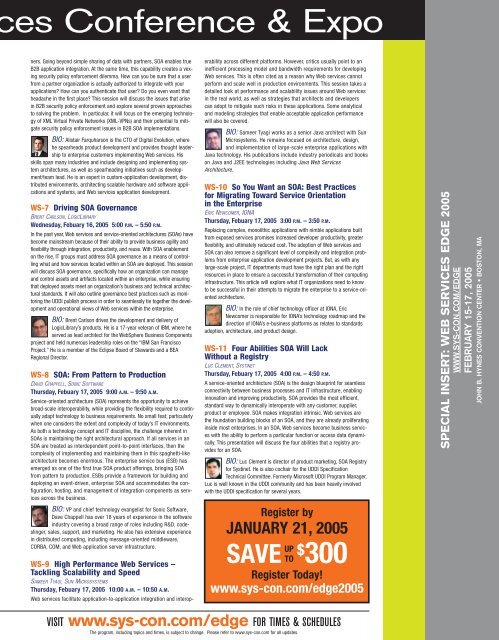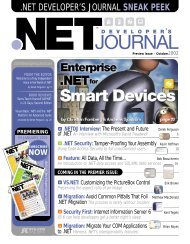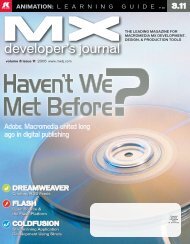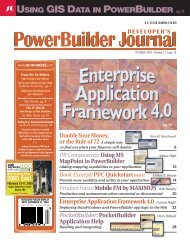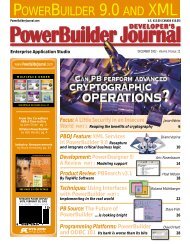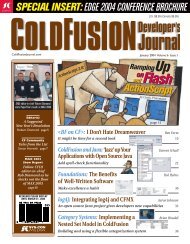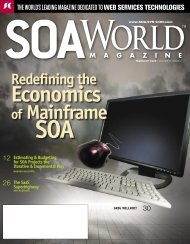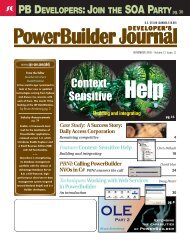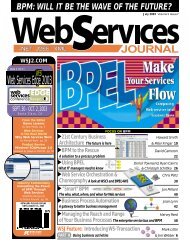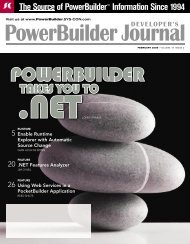JDJ 10-1.indd - sys-con.com's archive of magazines - SYS-CON Media
JDJ 10-1.indd - sys-con.com's archive of magazines - SYS-CON Media
JDJ 10-1.indd - sys-con.com's archive of magazines - SYS-CON Media
- No tags were found...
Create successful ePaper yourself
Turn your PDF publications into a flip-book with our unique Google optimized e-Paper software.
es Conference & Exponers. Going beyond simple sharing <strong>of</strong> data with partners, SOA enables trueB2B application integration. At the same time, this capability creates a vexingsecurity policy enforcement dilemma. How can you be sure that a userfrom a partner organization is actually authorized to integrate with yourapplications? How can you authenticate that user? Do you even want thatheadache in the first place? This session will discuss the issues that arisein B2B security policy enforcement and explore several proven approachesto solving the problem. In particular, it will focus on the emerging technology<strong>of</strong> XML Virtual Private Networks (XML-VPNs) and their potential to mitigatesecurity policy enforcement issues in B2B SOA implementations.BIO: Alistair Farquharson is the CTO <strong>of</strong> Digital Evolution, wherehe spearheads product development and provides thought leadershipto enterprise customers implementing Web services. Hisskills span many industries and include designing and implementing <strong>sys</strong>temarchitectures, as well as spearheading initiatives such as development/teamlead. He is an expert in custom-application development, distributedenvironments, architecting scalable hardware and s<strong>of</strong>tware applicationsand <strong>sys</strong>tems, and Web services application development.WS-7 Driving SOA GovernanceBRENT CARLSON,LOGICLIBRARYWednesday, Febuary 16, 2005 5:00 P.M. – 5:50 P.M.In the past year, Web services and service-oriented architectures (SOAs) havebecome mainstream because <strong>of</strong> their ability to provide business agility andflexibility through integration, productivity, and reuse. With SOA enablementon the rise, IT groups must address SOA governance as a means <strong>of</strong> <strong>con</strong>trollingwhat and how services located within an SOA are deployed. This sessionwill discuss SOA governance, specifically how an organization can manageand <strong>con</strong>trol assets and artifacts located within an enterprise, while ensuringthat deployed assets meet an organization’s business and technical architecturalstandards. It will also outline governance best practices such as monitoringthe UDDI publish process in order to seamlessly tie together the developmentand operational views <strong>of</strong> Web services within the enterprise.BIO: Brent Carlson drives the development and delivery <strong>of</strong>LogicLibrary’s products. He is a 17-year veteran <strong>of</strong> IBM, where heserved as lead architect for the WebSphere Business Componentsproject and held numerous leadership roles on the “IBM San FranciscoProject.” He is a member <strong>of</strong> the Eclipse Board <strong>of</strong> Stewards and a BEARegional Director.WS-8 SOA: From Pattern to ProductionDAVID CHAPPELL, SONIC SOFTWAREThursday, Febuary 17, 2005 9:00 A.M. – 9:50 A.M.Service-oriented architecture (SOA) represents the opportunity to achievebroad-scale interoperability, while providing the flexibility required to <strong>con</strong>tinuallyadapt technology to business requirements. No small feat, particularlywhen one <strong>con</strong>siders the extent and complexity <strong>of</strong> today’s IT environments.As both a technology <strong>con</strong>cept and IT discipline, the challenge inherent inSOAs is maintaining the right architectural approach. If all services in anSOA are treated as interdependent point-to-point interfaces, then thecomplexity <strong>of</strong> implementing and maintaining them in this spaghetti-likearchitecture becomes enormous. The enterprise service bus (ESB) hasemerged as one <strong>of</strong> the first true SOA product <strong>of</strong>ferings, bringing SOAfrom pattern to production. ESBs provide a framework for building anddeploying an event-driven, enterprise SOA and accommodates the <strong>con</strong>figuration,hosting, and management <strong>of</strong> integration components as servicesacross the business.BIO: VP and chief technology evangelist for Sonic S<strong>of</strong>tware,Dave Chappell has over 18 years <strong>of</strong> experience in the s<strong>of</strong>twareindustry covering a broad range <strong>of</strong> roles including R&D, codeslinger,sales, support, and marketing. He also has extensive experiencein distributed computing, including message-oriented middleware,CORBA, COM, and Web application server infrastructure.WS-9 High Performance Web Services –Tackling Scalability and SpeedSAMEER TYAGI, SUN MICRO<strong>SYS</strong>TEMSThursday, Febuary 17, 2005 <strong>10</strong>:00 A.M. – <strong>10</strong>:50 A.M.Web services facilitate application-to-application integration and interoperabilityacross different platforms. However, critics usually point to aninefficient processing model and bandwidth requirements for developingWeb services. This is <strong>of</strong>ten cited as a reason why Web services cannotperform and scale well in production environments. This session takes adetailed look at performance and scalability issues around Web servicesin the real world, as well as strategies that architects and developerscan adopt to mitigate such risks in these applications. Some analyticaland modeling strategies that enable acceptable application performancewill also be covered.BIO: Sameer Tyagi works as a senior Java architect with SunMicro<strong>sys</strong>tems. He remains focused on architecture, design,and implementation <strong>of</strong> large-scale enterprise applications withJava technology. His publications include industry periodicals and bookson Java and J2EE technologies including Java Web ServicesArchitecture.WS-<strong>10</strong> So You Want an SOA: Best Practicesfor Migrating Toward Service Orientationin the EnterpriseERIC NEWCOMER, IONAThursday, Febuary 17, 2005 3:00 P.M. – 3:50 P.M.Replacing complex, monolithic applications with nimble applications builtfrom exposed services promises increased developer productivity, greaterflexibility, and ultimately reduced cost. The adoption <strong>of</strong> Web services andSOA can also remove a significant level <strong>of</strong> complexity and integration problemsfrom enterprise application development projects. But, as with anylarge-scale project, IT departments must have the right plan and the rightresources in place to ensure a successful transformation <strong>of</strong> their computinginfrastructure. This article will explore what IT organizations need to knowto be successful in their attempts to migrate the enterprise to a service-orientedarchitecture.BIO: In the role <strong>of</strong> chief technology <strong>of</strong>ficer at IONA, EricNewcomer is responsible for IONA’s technology roadmap and thedirection <strong>of</strong> IONA’s e-business platforms as relates to standardsadoption, architecture, and product design.WS-11 Four Abilities SOA Will LackWithout a RegistryLUC CLEMENT,<strong>SYS</strong>TINETThursday, Febuary 17, 2005 4:00 P.M. – 4:50 P.M.A service-oriented architecture (SOA) is the design blueprint for seamless<strong>con</strong>nectivity between business processes and IT infrastructure, enablinginnovation and improving productivity. SOA provides the most efficient,standard way to dynamically interoperate with any customer, supplier,product or employee. SOA makes integration intrinsic. Web services arethe foundation building blocks <strong>of</strong> an SOA, and they are already proliferatinginside most enterprises. In an SOA, Web services become business serviceswith the ability to perform a particular function or access data dynamically.This presentation will discuss the four abilities that a registry providesfor an SOA.BIO: Luc Clement is director <strong>of</strong> product marketing, SOA Registryfor Systinet. He is also cochair for the UDDI SpecificationTechnical Committee. Formerly Micros<strong>of</strong>t UDDI Program Manager,Luc is well known in the UDDI community and has been heavily involvedwith the UDDI specification for several years.Register byJANUARY 21, 2005UPSAVE $ 300TORegister Today!www.<strong>sys</strong>-<strong>con</strong>.com/edge2005SPECIAL INSERT: WEB SERVICES EDGE 2005WWW.<strong>SYS</strong>-<strong>CON</strong>.COM/EDGEFEBRUARY 15-17, 2005JOHN B. HYNES <strong>CON</strong>VENTION CENTER • BOSTON, MAVISIT www.<strong>sys</strong>-<strong>con</strong>.com/edge FOR TIMES & SCHEDULESThe program, including topics and times, is subject to change. Please refer to www.<strong>sys</strong>-<strong>con</strong>.com for all updates.


